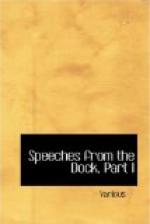John O’Mahony was a different stamp of man. He belonged to the class known as gentlemen-farmers, and of that class he was one of the most respected. His family owned a considerable tract of land in the southern part of the County of Tipperary, of which they had been occupants for many generations. He was well educated, of studious habits, and thoroughly imbued with patriotic feeling, which came to him as a hereditary possession. When the Young Ireland leaders were electrifying the country by their spirited appeals to the patriotism and bravery of the Irish race, and the population in all the chief centres of intelligence were crystalizing into semi-military organizations, O’Mahony was not apathetic or inactive. One of the strongest of the Confederate clubs—which were thick sown in the contiguous districts of the Counties of Cork, Waterford, and Tipperary—was under his presidency; and when in July, 1848, the leaders of the movement scattered themselves over the country for the purpose of ascertaining the degree of support they would receive if they should decide on unfurling the green banner, his report of the state of affairs in his district was one of their most cheering encouragements.
A few days afterwards the outbreak under O’Brien occurred at Ballingarry. The failure of that attempt, and the irresolute manner in which it was conducted, had disheartened the country, but the idea of allowing the struggle to rest at that point was not universally entertained by the leaders of the clubs; and John O’Mahony was one of those who resolved that another attempt should be made to rally the people to the insurrectionary standard. He acted up to his resolution. On the night of the 12th of September there were signal-fires on the slopes of Slievenamon and the Comeragh mountains, and the district between Carrick-on-Suir and Callan was in a state of perturbation. Next day the alarm was spread in all directions. The gentry of the disturbed districts rushed into the nearest towns for protection; police from the outlying barracks were called in to reinforce the threatened stations, and troops were hastily summoned from Dublin and the neighbouring garrisons. Meanwhile parties of the insurgents began to move about. One proceeded to the police station at the Slate-quarries, and finding it deserted—the policemen having retired on Piltown—burned it to the ground. Another attempted the destruction of Grany bridge, to delay the advance of the soldiery. A third proceeded to attack the Glenbower station.




